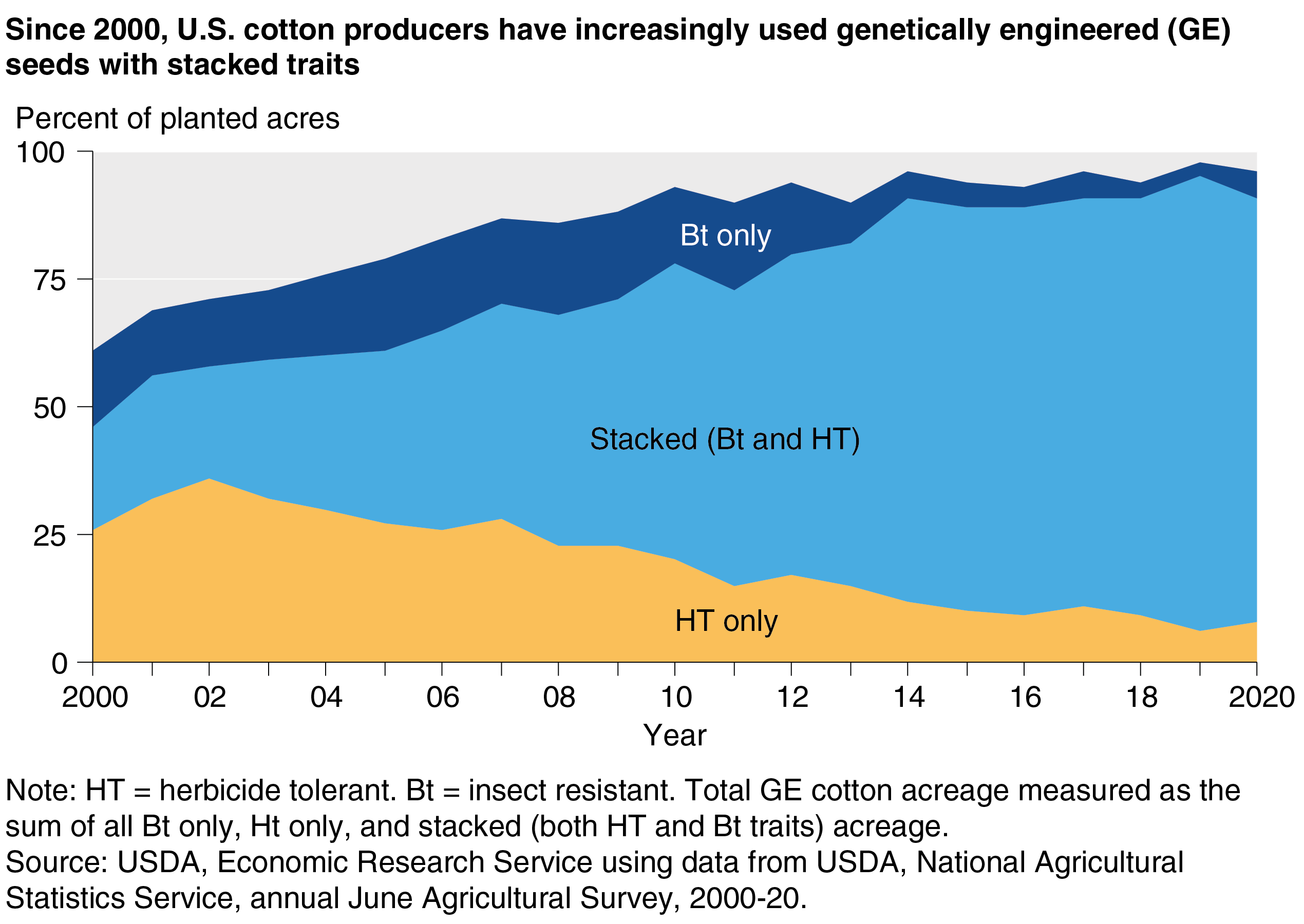
Use of Genetically Engineered Cotton Has Shifted Toward Stacked Seed Traits
- by Laura Dodson
- 12/7/2020
Genetic engineering (GE) is a key component of modern agricultural biotechnology. GE techniques allow a precise alteration of a plant’s traits to produce characteristics not possible through traditional plant breeding. These techniques also reduce the number of unintended characteristics that may occur with traditional breeding.
GE crops are broadly classified as herbicide-tolerant (HT), insect-resistant (Bt), or “stacked” varieties that combine HT and Bt traits. HT crops can tolerate one or more herbicides and provide farmers with a broad variety of options for effective weed control by targeting weeds without damaging crops. Bt crops contain genes from the soil bacterium Bacillus thuringiensis and provide effective control of insect pests, such as the tobacco budworm and pink bollworm. Although other GE traits have been developed (such as virus and fungus resistance, drought resistance, and enhanced protein, oil, or vitamin content), HT and Bt traits are the most commonly used traits in U.S. crop production.
GE cotton was commercially introduced in the United States in 1995, and adoption rates increased rapidly in the years that followed. Genetically engineered seeds have accounted for the majority of cotton acres since 2000, expanding from 61 percent of acreage that year to 96 percent in 2020. During this time, the share of cotton acres planted with seeds that had the individual HT or Bt traits shrank as growers turned more often to stacked varieties that carried both traits. In 2000, about 26 percent of total cotton acres were HT only, 15 percent were Bt only, and 20 percent used stacked seeds. By 2020, 8 percent of acres were HT only, 5 percent were Bt only, and 83 percent used stacked seeds.
Growers have transitioned to stacked seeds for many reasons, including the wider availability of stacked products for growers. The first stacked seed traits, introduced in the late 1990s, added Bt traits to existing HT seeds. Since then, weed management has become more complex with the emergence of herbicide-resistant weed species and Bt-resistant pests. Stacked seeds with multiple traits allow farmers to pursue many different options for pest management, such as resistance to multiple herbicides—including glyphosate, glufosinate, and dicamba.
This article is drawn from:
- Adoption of Genetically Engineered Crops in the United States. (n.d.). U.S. Department of Agriculture, Economic Research Service.
You may also like:
- Wechsler, S.J. (2018, December 3). Trends in the Adoption of Genetically Engineered Corn, Cotton, and Soybeans. Amber Waves, U.S. Department of Agriculture, Economic Research Service.
- Biotechnology. (n.d.). U.S. Department of Agriculture, Economic Research Service.
- McFadden, J., Smith, D., Wechsler, S.J. & Wallander, S. (2019). Development, Adoption, and Management of Drought-Tolerant Corn in the United States. U.S. Department of Agriculture, Economic Research Service. EIB-204.
- Fernandez-Cornejo, J., Wechsler, S.J. & Milkove, D. (2016). The Adoption of Genetically Engineered Alfalfa, Canola and Sugarbeets in the United States. U.S. Department of Agriculture, Economic Research Service. EIB-163.
- Fernandez-Cornejo, J., Wechsler, S.J., Livingston, M. & Mitchell, L. (2014). Genetically Engineered Crops in the United States. U.S. Department of Agriculture, Economic Research Service. ERR-162.
- Fernandez-Cornejo, J. & Caswell, M. (2006). The First Decade of Genetically Engineered Crops in the United States. U.S. Department of Agriculture, Economic Research Service. EIB-11.


